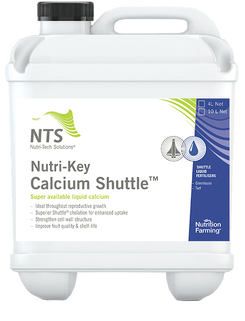NTS Calcium Shuttle
Typical AnalysisTotal Calcium (Ca) . . . . . . . . . . . . . . . . . . . . . . . . . . 9.81%
Calcium (as nitrate) . . . . . . . . . . . . . . . . . . . 9.80% Calcium (as organic) . . . . . . . . . . . . . . . . . . . 0.01% Total Nitrogen (N) . . . . . . . . . . . . . . . . . . . . . . . . . . . 7.25% Nitrogen (N) (as organic) . . . . . . . . . . . . . . 0.64% Nitrogen (N) (as nitrate) . . . . . . . . . . . . . . . 6.61% Total Potassium (K) . . . . . . . . . . . . . . . . . . . . . . . . . . . 0.23% Potassium (as organic) . . . . . . . . . . . . . . . . . 0.14% Potassium (as hydroxide) . . . . . . . . . . . . . . . 0.07% Potassium (as silicate) . . . . . . . . . . . . . . . . . . 0.02% Carbon (C) (as Shuttle chelator) . . . . . . . . . . . . . . 5.27% Sulfur (S) . . . . . . . . . . . . . . . . . . . . . . . . . . . . . . . . . . 0.26% Iron (Fe) . . . . . . . . . . . . . . . . . . . . . . . . . . . . . . . . . . . 0.15% Zinc (Zn) . . . . . . . . . . . . . . . . . . . . . . . . . . . . . . . . 930 mg/L Manganese (Mn) . . . . . . . . . . . . . . . . . . . . . . . . 757 mg/L Boron (B) . . . . . . . . . . . . . . . . . . . . . . . . . . . . . . . 433 mg/L Magnesium (Mg) . . . . . . . . . . . . . . . . . . . . . . . 363 mg/L Copper (Cu) . . . . . . . . . . . . . . . . . . . . . . . . . . . . . 245 mg/L Silicon (Si) . . . . . . . . . . . . . . . . . . . . . . . . . . . . . . . 217 mg/L Molybdenum (Mo) . . . . . . . . . . . . . . . . . . . . . . . . 49 mg/L SG . . . . . . . . . . . . . . . . . . . . . . . . . . . . . . . . . . . . . . . . . . . . 1.3 pH . . . . . . . . . . . . . . . . . . . . . . . . . . . . . . . . . . . . . .6.5 – 7.5 |
BenefitsCalcium plays a key role in protecting the cell from toxins and in slowing the ageing process. Adequate fruit calcium assists longer storage life and helps stored fruit resist a range of breakdown conditions and rots. The Shuttle® system delivers calcium in a highly plant available complexed form. Nutri-Key Calcium Shuttle™ offers calcium in a balanced formulation which covers the full spectrum of “background nutrition”.
What's in it? Contains “background nutrients” to avoid the problems that can occur when the correction of one shortage triggers another shortage due to the antagonistic effect of certain elements. |


